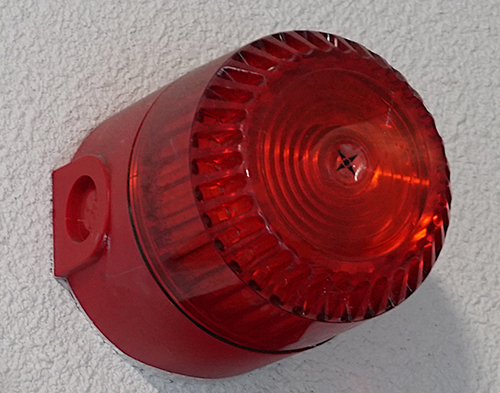
BS 8629:2019 - Code of practice for the design, installation, commissioning and maintenance of evacuation alert systems for use by the Fire and Rescue Service in buildings containing flats
What is an evacuation alert system?
A new British Standard has been published that sets out the requirements for an Evacuation Alert System (EAS), for use by the Fire and Rescue Service (FRS). The standard is entitled ‘Code of practice for the design, installation, commissioning and maintenance of evacuation alert systems for use by the Fire and Rescue Service in buildings containing flats.’
The purpose of an EAS is to assist the FRS with initiating an evacuation of part in the unlikely event it becomes necessary, the whole of the building, typically high-rise blocks of flats that, otherwise, have a 'stay-put' strategy.
The system comprises an evacuation alert control panel with indicating equipment (EACIE) located in a suitable low-risk location and sounders within each dwelling, with the system being under the control of the FRS.
How common are fires in blocks of flats?
Every day in England there are 20-30 fires that occur in blocks of flats. The fire is usually contained within the flat of origin and the need to evacuate is very rare. However, whilst fire spreading to other flats is not common, it can happen if the appropriate precautions are not in place, such as fire-stopping and adequate separation.
Why aren’t people usually evacuated from high-rise buildings?
High-rise buildings present unique dangers with respect to simultaneous evacuation. Simultaneous evacuation can lead to large numbers of people trying to escape at once, possibly down a single staircase, with the group likely to consist of a mixture of young, elderly and infirm people. Such a situation is not desirable when the FRS may need to go up the staircase with heavy equipment. Directing people into smoke-filled areas, meaning that it would be safer for people to remain in their flats. It is for this reason that most high-rise buildings operate a design strategy that implements the ‘stay-put’ policy. This policy has been proved to be effective over many years.
What is the ‘stay-put’ policy?
The building design strategy for most high-rise buildings containing flats is to operate a ‘stay-put’ policy. This is an established strategy whereby individual flats are designed with fire-rated compartmentation to ensure that fire cannot spread between flats, with occupants instructed to stay put unless they are instructed to evacuate by the FRS. This system generally works well, but there may be occasions when the FRS needs to change its plans and evacuate part or all of a building. At present, the only way to achieve this is to send firefighters to knock on residents’ doors – which may not always be possible.
Do I need to install an EAS?
Following the tragic events at Grenfell Tower, the Scottish Government formed an expert review panel to look at Scottish Building Regulations.
Following the review, the panel made a recommendation to the Scottish Government to amend the Domestic Technical Handbook (DTH), which was accepted. The new requirement states that all blocks of flats with a storey located at a height of more than 18 metres above ground level must incorporate a system to allow the FRS to initiate an evacuation signal within each flat.
The DTH was revised and published on 1 October 2019. It recommends that an EAS is installed to ensure compliance with mandatory Building Standard 2.14 Fire and Rescue Service Facilities under Scottish Building Regulations. This Standard requires that every building must be designed and constructed in such a way that facilities are provided to assist fire-fighting or rescue operations.
At present in England there is no requirement to install an EAS; however, there is nothing to prevent such a system being specified as part of the overall fire strategy for a building. The Grenfell Inquiry Phase 1 report recommends that such systems be installed in all new and existing blocks of flats. In addition, the Ministry of Housing, Communities and Local Government (MHCLG) carried out a public consultation on the requirement for such provision in all new high-rise blocks of flats.
It is worth contacting the FRS at the design stage of a project to discuss any possible benefits of installing an EAS. Following completion of the project, it is important to advise the FRS of the existence of such a system and allow them to familiarize themselves with its location and use.
Is an EAS different to a fire alarm system?
An EAS is different to a fire detection and alarm system (FDAS), as it is only intended to be used by the FRS and will probably never be used in a real evacuation. It is imperative to ensure that the system is maintained and is fully functioning. Whilst the EAS may never be used, it is likely to save lives if needed.
It is important to ensure that the design and layout of the control panel and indicating equipment is intuitive, consistent and easy to use for the FRS. The layout of the EACIE is required to be displayed in a vertical arrangement, to resemble the floor layout. To encourage the use of a dynamic thought process in the evacuation strategy, a conscious decision was made by the committee not to provide one single button to evacuate the whole building.
Careful consideration was also given as to whether to integrate the EAS system into existing fire alarm installations. However, the committee responsible for producing the standard, decided that integration would be inappropriate. This was for a number of reasons, including the fact that most blocks of flats do not feature communal fire alarm systems, as this is not a requirement of BS 5839-1, and therefore, the wiring would not already be in place or suitable. Non-integration also keeps the EAS independent and reduces the likelihood of failure. Another good reason for keeping the systems separate is that existing fire alarm maintenance companies would be unlikely to be familiar with the systems.
Another important consideration is the alarm sound. There are arguments for and against the use of voice alarms in this type of installation. Whilst voice alarms can sometimes be more effective than an alarm sounder, it must be borne in mind that 22 different languages were spoken by the residents of Grenfell Tower. The committee carefully considered the use of voice alarm systems, but it was decided that these would be inappropriate for an EAS. Evacuation alert devices or visual alarm devices (VADS) are used instead to alert occupants to the need to evacuate.
 What are visual alarm devices?
What are visual alarm devices?
Visual Alarm Devices or VADs, more commonly known as ‘flashing beacons,’ are used to alert people with hearing difficulties or for areas with a high ambient background noise. Devices installed after 1 January 2014 must comply with BS EN 54-23 under the Construction Products Regulation (CPR). This Standard ensures that devices have been tested to provide a minimum light output in relation to the size of the protected area. They are referred to as ‘visual evacuation alert devices’ within BS 8629:2019.
What type of wiring is required for an EAS?
The wiring for an EAS falls under the requirements of BS 7671:2018; Regulation 521.10.202 states that “wiring systems shall be supported such that they will not be liable to premature collapse in the event of a fire”. This means that cables must be installed with non-combustible supports.
Cables that are used for critical signal paths may be subjected to fire conditions and must remain operational for an adequate duration. It is for this reason that BS 8629:2019 requires enhanced cables, which have a survival time of 120 minutes when tested in accordance with BS EN 50200 or BS 8434-2.
The requirements of BS 8629:2019 for segregation align with those of BS 7671:2018, Regulation 560.7.1, which states that “except where the recommendations of other safety standards apply, circuits of safety services shall be independent of other circuits”. An explanatory note reads:
“This means that any electrical fault or any intervention or modification in one system must not affect the correct functioning of the other. This may necessitate separation by fire-resistant materials or different routes or enclosures.”
BS 8629:2019 states that ”the circuits of evacuation systems need to be segregated from the cables of other circuits to minimize any potential for other circuits to cause malfunction of the evacuation system”. Malfunction could be caused by several factors, such as breakdown of the cable insulation of other circuits and/or evacuation system circuits, a fire caused by a fault on another circuit, electromagnetic interference to any evacuation system circuit as a result of the proximity of another circuit, or damage resulting from the need for other circuits to be installed in, or removed from, ducts or trunking containing an evacuation system circuit.
Resilience
As with any critical safety service, resilience is essential to provide assurance of continuity of service. BS 8629:2019 requires that the system is designed in such a way to minimize multiple alarm zones failing simultaneously. Diverse and protected cable routes, and the quantity and size of the loops, are also design considerations intended to minimize this risk.
Power supply
The power supply for an EAS is required to conform to BS EN 54-4, which sets out the requirements for power supplies and battery charging. The batteries are required to be of sufficient capacity to maintain the system in operation for at least 72 hours, after which sufficient capacity should remain to provide an evacuation signal in all alarm zones for at least 30 minutes unless the building is provided with an automatically started standby generator.
Security rating
As the EAS is designed to be operated by the FRS only, the correct security rating for the enclosure of the EAS is extremely important, to prevent unauthorized access. It would be undesirable for the system to fall into the wrong hands, as the building could then be evacuated simultaneously, posing a risk. It is for this reason that BS 8629:2019 requires the EACIE to be installed within a security-rated enclosure. The enclosure must be certified under Loss Prevention Standard (LPS) 1175 – one of many LPS standards published by the Loss Prevention Certification Board (LPCB).
LPS 1175 offers various categories of security rating, according to different attack duration times and tool kits. BS 8629 requires a minimum security rating of B5, which means that the enclosure can withstand an attack for five minutes with tool kit B. The enclosure will be accessible using a key with a restricted profile for use by the FRS only.
Summary
It is worth considering installing an EAS in buildings with specific risks. Consultation with the FRS is recommended to fully understand the benefits and requirements.
An EAS is an excellent way to alert residents to evacuate a building if required. Not only could it reduce evacuation time, but it could also prevent firefighters from having to knock on doors, further reducing risk.
It is important to note the difference between an EAS and an FDAS and to understand that the EAS is only intended to be operated by the FRS.
Other sources of useful information
- BS 7671:2018+A1:2020 The IET Wiring Regulations, Requirements for Electrical Installations
- BS EN 54-4:1998 Fire detection and fire alarm systems, power supply equipment
- BS EN 50200:2015 Method of test for resistance to fire of unprotected small cables for use in emergency circuits
- BS 8434-2:2003+A2:2009 Methods of test for assessment of the fire integrity of electric cables. Test for unprotected small cables for use in emergency circuits
- Loss Prevention Standard (LPS) 1175, Issue 8
- Building Standards Technical Handbook 2019: Domestic buildings (DTH, Scotland)
